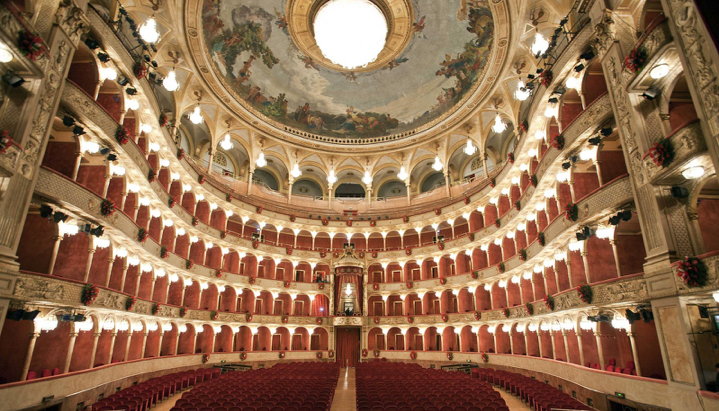INSPIRATION / A Trick of the Eye
Teatro Costanzi (Teatro dell’Opera di Roma), Rome. Photo: Corrado Maria Falsini
Having an old-meets-new moment at the Teatro Costanzi in Rome, with a trove of old frescoes by Annibale Brugnoli and the trompe l’oeil sets designed by artist Ignasi Monreal. The vast, striking sets were designed for the recent La Bayadère ballet at Opera Roma, performed at the end of February 2023 (scroll down). Also, sneaking in a few notes and image from our visit to the Cézanne exhibition at Tate Modern a couple of weeks ago.
Brugnoli (1843-1915) was born in Perugia and studied at the Accademia di Belle Arti di Perugia under Silvestro Valeri before moving to Napoli to work in the studio with influential painter Domenico Morelli. He authored two small books but was most in demand as a fresco artist. Brugnoli frescoed the Italian Pavilion at the Parisian Expo in 1878, decorated the grand hall of Villa Marsaglia as well as numerous other cupole and salons, and also the hall of the Commercial Bank of Perugia. He usually depicted historical scenes.
Brugnoli’s frescoes in the Teatro. Photo: Luxury Rome Magazine
The frescoed dome boldly and lyrically depicts groups of allegorical figures celebrating shows ranging from tragedy to dance. Its centrepiece is a Murano chandelier, one of the largest in Europe, added in 1928 and featuring 27,000 crystal drops.
Photo: World of Interiors
For the ballet, Ignasi Monreal created impressive set designs inspired diversely by the likes of Léon Bakst and Alice in Wonderland. Crafted in a repurposed pasta factory, at the Laboratorio di Scenografia near Palatine Hill, Ignasi's animated dreamscape-like sketches were scaled up from iPad drawings by the Laboratorio team. Painted deftly with tall brush-tipped poles and the floor as easel, the pieces had to be checked frequently from 9m high platforms. And the team also mixed their tempera in-house to a hundred year old recipe.
Ignasi’s set designs for La Bayadère, being created at the Laboratorio di Scenografia. Photo: Anna Huix
Not sure if it's the scope and design - or the scale of the artwork - or the vast pre-production setting - or the artisan skills - or probably what is a combination of all of the above - but you can't help but feel a sense of immovable awe, wonder and wholly believable illusion. Only wish we had been in Rome!
[Further reading: La Bayadère boys article in FTHTSI by Maria Shollenbarger 5 Feb 23, and Aggrandised Designs article in The World of Interiors by Leyla Spratley 24 Feb 23].
Lots of scale-play in ‘The Kingdom of Shades’ dream sequence. Photo: World of Interiors
Richness and drama in the betrothal scene at the House of the Rajah. Photo: World of Interiors
Now, back to London… where we managed to catch the last couple of weeks of the Cézanne exhibition at Tate Modern. Cézanne is one of Charles’ favourite artists so a visit was essential, and the children had also been studying Cézanne which meant it doubled as a suitably educational day out. Our eldest son was in awe that the paintings were the ‘real thing’ from the time they were made (he double-checked excitedly half way through the exhibition) which reminded us of what a privilege it was to see a collected body of Cézanne’s works painted across his lifetime, in person. Loved his limited colour palette, the subject matter, the finished-unfinished ones, the up-close details, and strokes and layering of paint.
Never tiring of Provençal landscapes, a juicy peach, or the fabric folds of his still lifes, we spent a good couple of hours taking it all in. Everyone finds their favourite moments in an exhibition, and it’s so important to experience things for yourself and find your own treasures (especially in an age where other people’s images usually precede or replace our experience of things…) but here are a few of our highlights for posterity, the curious, or in case you were unable to visit. (Please excuse any wonky and imperfect cropping - other than the intentionally cropped details - trying to eliminate the heavy ornate framing).





















